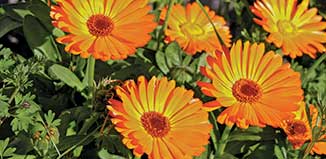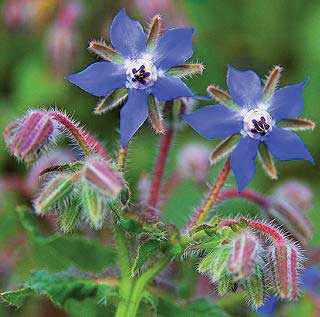
The culinary use of flowers, particularly those of herbs, dates back thousands of years. You’ll find rose petals in many Indian dishes, squash blossoms in Italian, and lotus flowers and water lilies are used in Asian cultures – lotus rhizomes, or roots, are delicious stir fried as a vegetable — crunchy and spicy!
To be sure edible flowers are safe to eat, it’s best to grow your own. Roadside flowers will have been polluted by car exhaust, those picked in public places have probably been sprayed with toxic garden spray, and some bought flowers have been chemically treated to keep them fresh as cut flowers, and to give them a longer vase life. If you have doubts about using a flower, then don’t.
Safe flowers to use include herb members of the mint family, such as sage, rosemary, thyme and oregano, which are commonly used to add flavour in cooked meat, grain and vegetable dishes, so there’s no reason why you shouldn’t use their flowers also. If your herb can be eaten, then it will also be safe to use its flowers.
The flowers of mint range in flavour from very mild, such as apple mint, through to the heady pungency of eau de Cologne or basil mint. Other members of the mint family, like hyssop and lemon balm also produce edible flowers.
Herbs from the parsley family include dill, celery and fennel, but although all flower freely, their flowers have a strong, bitter flavour — they’re best left to produce the seed which has many culinary uses.

Borage flowers are a pretty sky-blue and have a light cucumber taste, great in fruit salads, green salads or frozen in ice cubes for cold drinks.
The colourful blossoms of nasturtiums have a peppery flavour, much like watercress, and all colours and varieties are tasty in salads or as garnishes — the leaves can be eaten also.
Calendula flowers range in colour from pure yellow to orange and red, and they’re an easy and prolific edible flower that’s easy to grow from seed — separate petals from the centre of the flower, and sprinkle into salads and cold dishes. If you remove spent flowers, plants will bloom continuously from early summer into late autumn.
Daylilies and squash blossoms taste a little like asparagus, and can be used as a garnish, or made into fitters — they’re also good in a stir-fry.
The flowers of chives, leeks and garlic are all delicious in green salads, potato and pasta salads and dips — remove the central stem from the flower cluster to release the separate florets.
Scarlet runner beans produce bright red flowers, which are great mixed into a salad, or with steamed veggies, and the tiny flowers of violas, such as Johnny Jump-up, have a wintergreen flavour, and look pretty on cakes and other desserts — you could glaze with warmed jelly for a jewelled look.
Flowers will always taste and look their best immediately after they’ve opened, but you can keep blooms fresh by placing on a moist paper towel, and refrigerating in an airtight container — some will last up to ten days this way. Ice water can also revitalise blooms.

